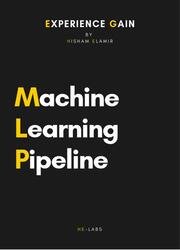Machine Learning Pipeline: Experience Gain
- Добавил: literator
- Дата: 2-01-2021, 20:00
- Комментариев: 0
 Название: Machine Learning Pipeline: Experience Gain
Название: Machine Learning Pipeline: Experience GainАвтор: Hisham Elamir
Издательство: Leanpub
Год: 2019
Страниц: 152
Язык: английский
Формат: pdf, mobi, epub
Размер: 10.1 MB
By reading this book you will learn how to build a Machine Learning pipeline for a real-life projects, whatever stopped you before from mastering Machine Learning with Python you can easily overcome it with this book, because of easy step-by-step, and example-oriented approach that will help you apply the most straightforward and effective tools to both demonstrative and real-world problems and datasets.
The rapid development of Machine Learning applications is fueled by an ongoing struggle to continually innovate, playing out at lots of research labs. The techniques developed by these pioneers are seeding new application areas and experiencing growing public awareness. All these inventions have some pattern or to be specific, each has its own workflow that people can flow and build above it.
With all of these possibilities and more at the fingertips of the committed data scientist, the profession is seeing a meteoric, if clumsy, growth. Not only are there far more data scientists and AI practitioners now than there were even many years ago, but the accessibility and openness around solutions at the high end of machine learning research has increased.
What all of this means is that there may never have been a better time to move into the field of data science and develop your machine learning skill set. The introductory algorithms (including clustering, regression models, and neural network architectures) and tools are widely covered in web courses and blog content, also the techniques at the cutting edge of data science (including deep learning, semi-supervised algorithms, and ensembles) are exists.
While the whole workflow or pipeline of the Machine Learning remain less accessible, most of companies build their own pipeline for their projects and hide them for commercial purpose. All that's needed is the combination of theoretical knowledge and practical guidance to implement models correctly. That is the requirement that this book was written to address.
What do you need for this book?
The entirety of this book's content leverages openly available data and code, including open source Python/R libraries and frameworks. While each chapter's example code is accompanied by a requirements file documenting all the libraries required to run the code provided in that chapter's accompanying scripts, the content of these files is collated here for your convenience.
Who this book is for?
This book is either Python/R developers and analysts or data scientists who are looking to add to or enhance their existing skills by accessing some of the most powerful recent trends in data science. If you've ever considered building your own image or text-tagging solution or entering a Kaggle contest, for instance, this book is for you! Prior experience of Python/R would be helpful.
Скачать Machine Learning Pipeline: Experience Gain
Внимание
Уважаемый посетитель, Вы зашли на сайт как незарегистрированный пользователь.
Мы рекомендуем Вам зарегистрироваться либо войти на сайт под своим именем.
Уважаемый посетитель, Вы зашли на сайт как незарегистрированный пользователь.
Мы рекомендуем Вам зарегистрироваться либо войти на сайт под своим именем.
Информация
Посетители, находящиеся в группе Гости, не могут оставлять комментарии к данной публикации.
Посетители, находящиеся в группе Гости, не могут оставлять комментарии к данной публикации.
